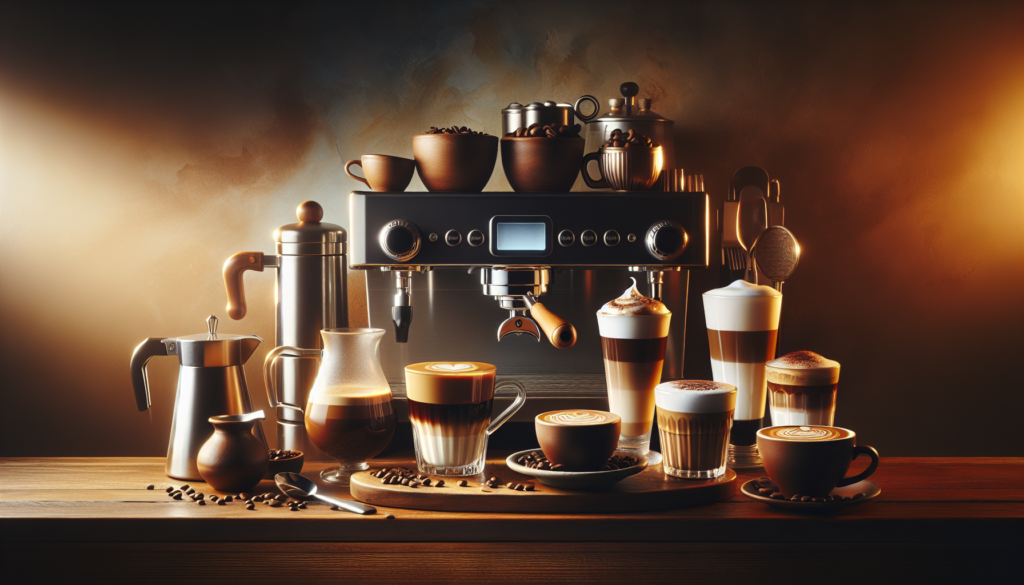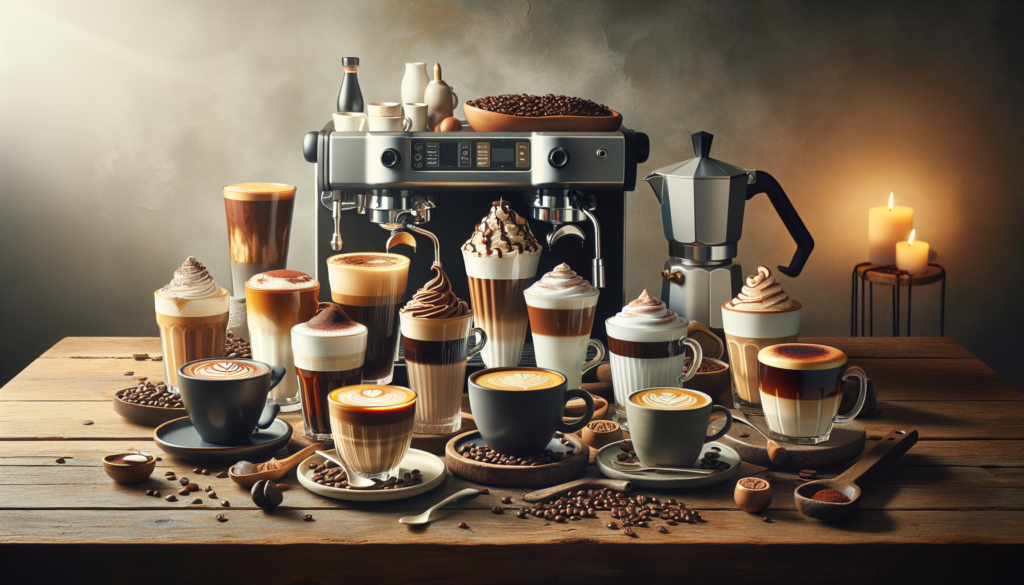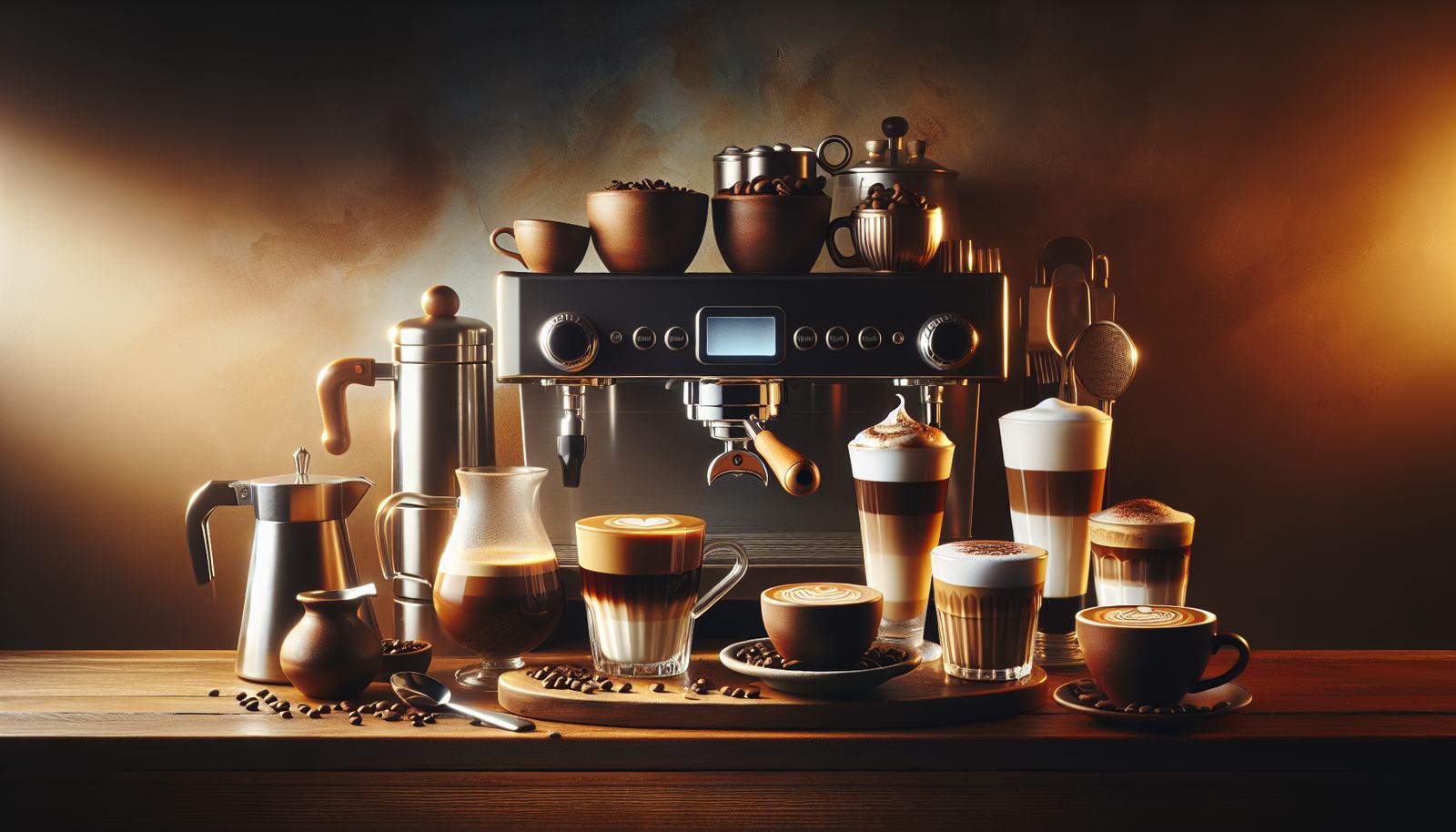If you’re new to the world of espresso, navigating through the countless options can be quite overwhelming. But fear not, because this article is here to help! In this guide, we’ll explore some of the best espresso drinks for beginners, taking into consideration their flavors, complexity, and preparation methods. Whether you’re looking for a sweet and creamy treat or a bold and intense shot of caffeine, we’ve got you covered. So grab your favorite mug, sit back, and get ready to embark on your espresso adventure!
1. What is Espresso?
– Definition of espresso
Espresso is a concentrated coffee beverage that is made by forcing hot water through finely ground coffee beans. It is brewed quickly using high pressure, resulting in a strong and rich flavor profile.
– How it is different from regular coffee
Espresso differs from regular coffee in several ways. Firstly, the brewing process for espresso involves using pressure to extract the coffee flavors quickly, whereas regular coffee is brewed by steeping the coffee grounds in hot water. This difference in brewing methods leads to variations in taste and strength. Espresso tends to have a bolder and more intense flavor compared to regular coffee.
2. Basic Espresso Equipment
Before diving into the world of espresso, it’s important to have the necessary equipment to make a delicious cup. Here are the essential tools you’ll need:
– Espresso machine
An espresso machine is the primary equipment used to brew espresso. It uses pressure to force hot water through the coffee grounds, resulting in a concentrated shot of espresso.
– Grinder
To achieve the perfect extraction, it’s crucial to grind your coffee beans just before brewing. A quality grinder will ensure a consistent grind size, which is essential for espresso brewing.
– Tamper
A tamper is a tool used to evenly compact the coffee grounds in the portafilter, a part of the espresso machine. This ensures a level surface and even extraction during the brewing process.
– Espresso cups
Traditional espresso cups are small, ceramic cups designed to hold a single shot of espresso. These cups have thick walls to retain heat and showcase the espresso’s crema.
– Milk frother
If you enjoy milk-based espresso beverages like lattes or cappuccinos, a milk frother is essential. It creates the creamy foam that tops these drinks and adds a touch of indulgence.

3. Understanding Espresso Variations
Espresso can be enjoyed in various ways, each having its own unique characteristics and flavor profiles. Here are some popular espresso variations to explore:
– Straight espresso
A straight espresso is a single shot of concentrated coffee served in a small cup. It is enjoyed for its intense flavor and aroma, as well as its ability to provide a quick burst of energy.
– Espresso macchiato
An espresso macchiato is a shot of espresso “stained” with a small amount of milk. This variation offers a balance between the strong espresso flavor and a touch of creamy sweetness.
– Cafe latte
Cafe latte is a milk-based espresso beverage consisting of espresso shots and steamed milk. It has a smooth and mellow flavor, with the milk providing a creamy texture.
– Cappuccino
Cappuccino is a classic espresso drink made with equal parts espresso, steamed milk, and milk foam. It has a rich and velvety texture, with a balanced combination of coffee and milk flavors.
4. Choosing the Right Coffee Beans
To achieve the best espresso experience, choosing the right coffee beans is crucial. Here are some factors to consider:
– Arabica vs. Robusta
Arabica and Robusta are the two main types of coffee beans. Arabica beans are generally considered superior in terms of flavor, acidity, and complexity. Robusta beans, on the other hand, are known for their higher caffeine content and stronger taste.
– Roast level
Different roast levels, such as light, medium, and dark, can significantly impact the flavor of the espresso. Lighter roasts tend to retain more subtle and nuanced flavors, while darker roasts have a bolder and more robust taste.
– Origin
Coffee beans from different regions have distinct flavor profiles. The origin of the beans can contribute to the overall taste and aroma of the espresso. Experimenting with beans from various origins can help you discover your preferred flavor profiles.
– Blend vs. single origin
Blends consist of a combination of coffee beans from different regions and can offer a balanced and consistent flavor profile. Single origin beans, on the other hand, showcase the unique characteristics of coffee from a specific region. Exploring both options can broaden your espresso experience.

5. Grinding Your Coffee Beans
The freshness and consistency of the coffee grind are essential for extracting the best flavors from your espresso. Consider the following factors:
– Importance of fresh grind
Grinding your coffee beans just before brewing is crucial for optimal flavor. Freshly ground coffee releases more aromatic oils and retains more complexity compared to pre-ground coffee.
– Consistency of grind size
The consistency of the grind size is crucial for espresso brewing. A consistent grind ensures even extraction and prevents over or under-extraction. Invest in a quality grinder and adjust the grind size according to your espresso machine’s specifications.
6. Brewing the Perfect Espresso Shot
Brewing an excellent espresso shot can be a combination of art and science. Pay attention to the following factors:
– Dosing and tamping
Dosing refers to the amount of ground coffee used in the portafilter. The correct dose ensures optimal extraction and a balanced flavor profile. Tamping, or compacting the coffee grounds evenly, ensures an even extraction. Use a tamper to achieve the right pressure during the tamping process.
– Extraction time
The extraction time, or the time it takes for water to pass through the coffee grounds, plays a crucial role in achieving a well-balanced espresso shot. Aim for a 25 to 30-second extraction time to yield a flavorful and aromatic shot.
– Water temperature
Water temperature affects the extraction process. The ideal temperature for brewing espresso is between 195 to 205 degrees Fahrenheit (90 to 96 degrees Celsius). This temperature range promotes optimal flavor extraction.
– Pressure
Espresso machines utilize pressure to force hot water through the coffee grounds. The correct pressure range for brewing espresso is typically around 9 bars. Consistent pressure ensures proper extraction and crema formation.
7. Frothing Milk for Espresso Drinks
If you enjoy milk-based espresso drinks, mastering the art of frothing milk is essential. Consider the following aspects:
– Types of milk for frothing
Different types of milk can yield different frothing results. Whole milk is commonly used for its creamy and rich texture, while non-dairy milk alternatives such as almond or oat milk can provide unique flavors and textures.
– Frothing techniques
There are various frothing techniques, ranging from using a steam wand on an espresso machine to using a handheld frother. It’s important to find a technique that works best for you and allows you to achieve your desired level of foam and texture.
– Achieving desired milk consistency
The desired milk consistency for espresso drinks varies depending on personal preference. Some prefer a thick and velvety microfoam, while others prefer a lighter and airier foam. Practice and experimentation will help you find the ideal milk consistency for your taste.
8. Best Espresso Drinks for Beginners
If you’re new to espresso, here are some beginner-friendly espresso drinks to explore:
– 1. Cortado
A cortado is a simple and elegant espresso-based drink made by combining an equal amount of espresso and warm, steamed milk. It offers a balanced flavor profile and is a great introduction to milk-based espresso drinks.
– 2. Flat White
Originating from Australia and New Zealand, a flat white is made by combining a double shot of espresso with velvety steamed milk. It has a rich and smooth texture, with a strong coffee flavor.
– 3. Americano
An Americano is a diluted espresso drink made by adding hot water to a single shot of espresso. It provides a milder and less intense flavor profile compared to straight espresso.
– 4. Mocha
A mocha is a delightful combination of espresso, steamed milk, and chocolate syrup. It offers a sweet and chocolaty twist to the classic espresso flavor, making it a popular choice among beginners.
– 5. Vanilla Latte
A vanilla latte is a creamy and comforting drink made with espresso, steamed milk, and a hint of vanilla syrup. It is a great option for those who enjoy a touch of sweetness in their espresso beverages.
9. Tips for Trying New Espresso Drinks
As you embark on your espresso journey, here are some tips for trying new espresso drinks:
– Start with small sizes
When trying new espresso drinks, it’s best to start with smaller sizes to avoid overwhelming your taste buds. This way, you can appreciate the flavors without feeling too full or jittery from excessive caffeine.
– Experiment with different flavors
Don’t be afraid to explore different flavor combinations. Add syrups, spices, or even a sprinkle of cocoa powder to customize your espresso drinks. Be open to trying new flavors and finding combinations that suit your taste preferences.
– Seek recommendations from baristas
Baristas are experts in the world of coffee and can offer valuable recommendations based on your taste preferences. Don’t hesitate to seek their advice and ask for suggestions when trying new espresso drinks.
10. Troubleshooting Common Espresso Issues
Even the most experienced espresso enthusiasts encounter issues from time to time. Here are some common problems and their potential solutions:
– Sour or bitter taste
If your espresso tastes sour, it could be under-extracted. Adjust the grind size to make it finer and increase the extraction time slightly. Conversely, if your espresso tastes bitter, it may be over-extracted. Try coarsening the grind size and reducing the extraction time.
– Weak or watery shot
A weak or watery shot may result from using a coarse grind size, insufficient coffee dose, or improper tamping. Ensure that you use the correct grind size, increase the coffee dose, and tamp the coffee evenly and firmly.
– Uneven extraction
An uneven extraction can lead to inconsistent flavors within your espresso shot. To address this issue, focus on achieving an even distribution of coffee grounds in the portafilter before tamping. Adjusting your tamping technique and exploring distribution tools can also help promote an even extraction.
By understanding the basics of espresso, exploring different variations, and honing your brewing skills, you’ll be well on your way to becoming an espresso aficionado. Enjoy the journey and savor each sip of your perfectly brewed espresso!

